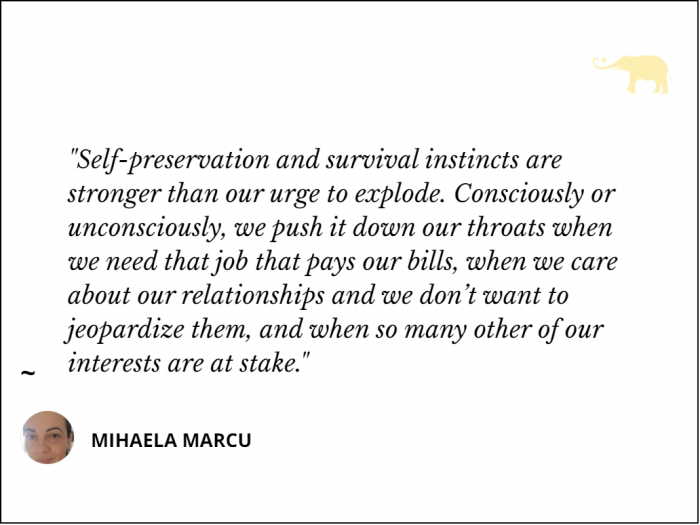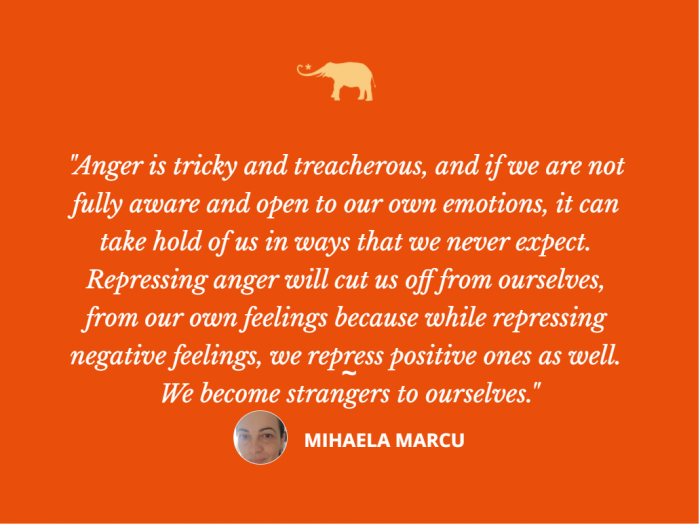View this post on Instagram
“I have an anger issue,” I replied to my friends who looked perplexed by my snapping at a simple, rather innocent person who made a common human and harmless mistake.
There it was, I admitted it loud and clear in front of my friends who knew me for so long for being a nice, kind person.
After the first waves of shame and more anger, this time at myself, I felt relieved. “Yes, I am a kind, nice person with an anger issue.”
Lashing out of anger is being judged rather harshly in our society. It might be more acceptable in some areas of Southern and Eastern Europe, but not if you are a woman. As a woman, you are quickly labeled as a hysteric b*tch. And we are being judged for the right reasons: who wants to be around an angry person? Angry women are ugly, and angry men scare us!
We all get angry even if we don’t always feel it or vent it out.
The state of the world today offers us plenty of reasons to get angry. Most of the time, we decide to suppress it or have repressed it before it even reaches our conscious mind. In his book, The Power of Letting Go, Dr. David Hawking says, “The quantity of suppressed anger in the population can be verified quickly by seeing how popular violence is in the media, where viewers are presented with a vicarious experience of letting out their anger in the form of beatings, shootings, stabbings, lynching, killings of various ‘bad guys.'”
Self-preservation and survival instincts are stronger than our urge to explode. Consciously or unconsciously, we push it down our throats when we need that job that pays our bills, when we care about our relationships and we don’t want to jeopardize them, and when so many other of our interests are at stake. And very often, we push it down because of the fear of being judged or simply because this is how we have been programmed.
In particular, in some parts of Western Europe, even more so in Scandinavian countries, venting anger is so unacceptable that children are tamed early in their lives and obliged to suppress their anger.
Anger builds on anger.
The problem is that anger builds up, and eventually, we will explode. And then we burst in the worse moment—not that there is a good moment to burst—or we express our anger against those who are innocent and most vulnerable because it is safer to lash out at them. We don’t have much to lose. Or so I thought. But if we are honest and care about how we treat other people, we have a lot to lose because the guilt and shame follows almost immediately.
Psychologist Dolf Zillman found through his studies that when the body is already in a stage of edginess and something triggers an emotional hijack, the subsequent emotion, whether anger or anxiety, is of especially great intensity. Once caught in the claws of the beast, our rational mind is kicked out of the window. The emotional, reptilian brain takes the stage, and once we let this happen, we are not in control of anything that happens next. Because our reptilian brain that is in charge of our primary needs is rude, it did not go to prep school, as Dr. David Hawkins explains. While our prefrontal cortex, or rational brain, learned to control certain instincts, the reptilian brain did not.
“You’ve learned not to respond to it, but that instinct to kill still comes up, as do other primitive impulses. Just notice your killer impulse when someone cuts you off in traffic.” ~ Dr. David Hawkins.
Repressed anger can be destructive.
One should rather be worried if anger never raises his/her pulse, even for a few seconds.
Anger not dealt with can be particularly destructive. The American author and Buddhist monk, Jack Kornfield, writes:
“In my own life, I’ve had to learn this with anger (…). So when I went to live as a young monk in a Thai forest monastery, I thought it would be easy and peaceful. I was unprepared for the intensity of my own restless mind, the uprising of grief, desire, and loneliness I felt. Most surprising was my anger. In not wanting to be like my violent father, I had suppressed all my anger—it had become dangerous even to feel. But in the awareness of meditation and solitude, all the things I was angry about came up. It was more than anger, it was fury. First at my father for being so hurtful to our family. Then, because it frightened me and I had denied it, I was angry at myself for all the times I had suppressed my anger.”
Anger is tricky and treacherous, and if we are not fully aware and open to our own emotions, it can take hold of us in ways that we never expect. Repressing anger will cut us off from ourselves, from our own feelings because while repressing negative feelings, we repress positive ones as well. We become strangers to ourselves.
Venting anger does not help to diffuse it.
So what shall we do? Lash out in small doses whenever we are triggered? The problem is that venting anger does not make it go away. “The expression of negative feelings allows just enough of the inner pressure to be let put so that the remainder can be suppressed.” ~ Dr. Hawkins.
Vented or not, suppressed or repressed, anger is bad for our health and we are all painfully aware of its ravages. The Buddha teaches us that “Holding onto anger is like drinking poison and expecting the other person to die.”
Then why do we keep drinking this poison?
I have been doing my inner work for more than 10 years now and I thought I was done with my anger. But it took me only to move to another country where my values clash way too often with the local culture and there I am, almost back from where I started.
Anger is one of the most common human emotions and an attractive one. Daniel Goleman writes in his international bestseller Emotional intelligence, “Anger is the most seductive of the negative emotions; the self-righteous inner monologue that propels it along fills the mind with the most convincing arguments for venting rage. Unlike sadness, anger is energizing, even exhilarating,” and David Hawkins notes that “There is a lot of energy in anger; we may actually feel energized when we are irritated or angry.”
The anatomy of anger, and is anger ever good?
Goleman explains that there are two types of anger. He says:
“The amygdala may well be the source of a sudden spark of rage we feel at the driver whose carelessness endangers us. But the other end of the emotional circuitry, the neocortex, most likely foments more calculated angers, such as cool-headed revenge or outrage at unfairness or injustice. Such thoughtful angers are most likely to ‘have good reasons’ or seem to.”
But is anger ever right or good? In other words, does it do any good to anyone to feel or to express anger?
David Hawkins teaches that we can use the energy of anger to move into actions necessary to fulfill the dreams of our life. The energy of anger can be directed into moving on to a new job or moving out of a relationship when our boundaries have been stepped on and the relationship becomes toxic. As opposed to guilt and shame, anger is energizing and it can give us the exact right push to move out of the rut.
However, venting anger is a different story. Social media abounds for such righteous indignation at people who do not share our values and the same love for animals and devotion for Mother Earth. What good does it bring anyone to shout at those who do not share or support the same vehemence perspectives when it comes to political and social issues? Unchecked anger will only engender further aggression.
Awareness is the key to dealing with anger in a healthy way.
The key to managing anger in a healthy way is self-awareness through constant self-observation. Observing what I am feeling now and questioning our thoughts (why am I feeling what I am feeling).
I have said that suppressing or repressing anger in order not to feel it can be dangerous. But expressing or venting anger is not good either. The key is to catch the feeling of anger as it arises and before it hijacks us, before we can get caught in the story the anger is telling us. This is why constant self-observation is paramount when we start working with anger until we learn to behave differently when we are triggered.
“One way of diffusing anger is to seize on and challenge the thoughts that trigger the surges of anger since it is the original appraisal of an interaction that confirms and encourages the first burst of anger, and the subsequent reappraisal that fan the flames. Timing matters; the earlier in the anger cycle, the more effective. Indeed, anger can be completely short-circuited if the mitigating information comes before the anger is acted on.” ~ Daniel Goldman.
At the root of our anger, there is almost always a perceived threat to our own existence. It is about our physical existence or our dignity, our perception that we have been subjected to some injustice and therefore taken advantage of.
It helps to check and let go of expectations from others, from ourselves, and from what we think our life should be like.
The truth is that our life almost never turns out—thankfully—the way we wanted. Mine did not, by far. But when you are open to life as it is, life does not take long to surprise you. When we allow ourselves to be an open container for life, negative and positive emotions come in and come out. Negative emotions will not stick long enough to make ravages. Only love remains because love is our essence.
We are not all the same when facing anger.
The fact is we are not all the same when facing anger. Some of us have been soaking in anger since early childhood, with one or even both parents lashing our anger frequently. Anger and aggression have been a constant during my childhood and this is how my parents managed their conflicts: with a lot of yelling and cursing. I am sure I am not the only one. My brain has been wired to resolve conflict by venting anger. Whenever challenged, my neurons automatically fire along the anger pathways. But it does not have to continue this way.
We now know about the neuroplasticity of our brain, which means that with self-awareness, self-compassion, and a lot of patience, we can build new neural pathways and therefore build different, automatic reactions to external stimuli.
How long does it take? For some months, for others years. When we think we let go of anger as I did, anger may sneak in again. Lingering residues may still be there and then it is easy to fall again into the grips of anger, though its hold on us is always weaker and weaker.
What is your experience with anger? Don’t hesitate to comment, write back to me, or tell your own love story with anger.













Read 4 comments and reply